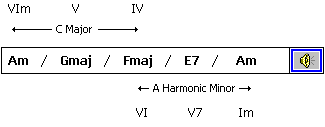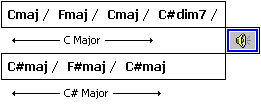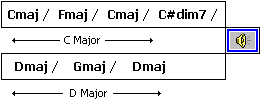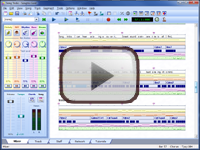(9.7) Modulating Between Keys
All of the chord progressions in the previous topic were built from related chords of the Major scale.
While Major scale harmonic movement appears in most pieces of music, you should consider it just the start of your experimentation. Each of the other scale types opens up a rich new world of harmonic expression.
It is also very common for music to change keys or scale types as it progresses. This is known as modulating between key centres, and it happens more often than you might think.
The chord progression below has a strong and integrated feel to its harmonic movement, and yet there is no Major, Harmonic Minor, or Melodic Minor scale which is related to all four of these chords.

A key centre is an area within a piece of music which is governed by a particular scale. This progression is moving between two key centres, and the chords can be expressed in roman numeral notation to show their role within each key centre.

Notice how the key centres overlap at the Fmaj and Am chords, which are related to both scales. This helps to give the progression a smooth feel with no obvious discontinuity where the key centres change.

In most ChordWizard products, the Relations tool provides a flexible multi-select option which makes it easy to work out when a group of chords are all related to the same scale in a key centre.
The term key centre is a useful one, if you think of the group of chords being centred around, and eventually wanting to resolve to, the home chord of the key.
In the example above, the chords Am-Gmaj-Fmaj could easily resolve to Cmaj, until the E7 appears. This shifts (modulates) the key centre, creating a need to resolve to Am instead.

Dominant seventh chords are often used for modulating between keys. The powerful V7-I movement is very effective for redirecting harmonic movement to a different key centre.
Modulation is also common between two different Major keys, and a dominant seventh chord is often the device which makes it happen. The progression below is quite happy in the key of C Major until the A7 appears, shifting the key centre to D Major instead.

In fact, if we replace the Dmaj with a D7, it also 'passes the buck' - modulating the key centre onwards to G Major.

And if we change the Gmaj to a G7, it brings the harmonic movement round a full circle back to C Major again. Notice how these key centres are moving in the same order as within the circle of fifths we looked at earlier.

While these progressions work harmonically, the 'swerve' as each key centre changes is quite noticeable. By contrast, the following progression also changes key centres repeatedly, also using the dominant seventh, but it has a more subtle, tension-building feel.

All of the key centre changes so far have been temporary excursions into a different harmonic space, before returning to the original key again. Incorporating movements like this into your compositions will tend to create much more interesting and distinctive music.
There is another type of key change, though, that is more permanent. It is almost always a shift upwards in pitch to a parallel key of the same scale type, and works well towards the end of a song to crank up the tension in a repeated chorus.
While the dominant seventh (7) chord works well for transient key changes, the diminished seventh (dim7) chord usually works better for shifting the harmonic movement to a new key centre and keeping it there.

The symmetrical intervals of the diminshed seventh chord means that it is not strictly related to any Major scale. As a result, it seems to create a neutral harmonic space, which can be readily steered to a variety of other key centres. Here is another similar example.

|
Topic 114 of 117
| ||
Bring these music concepts to life with the free Songtrix Bronze Edition as you create songs from chords and scales.
Then publish and share your ideas with the other musicians you meet on the ChordWizard Network.
Have questions? Join the ChordWizard Network and post them in the Music Theory forum for answers and discussions on your topics of interest.








